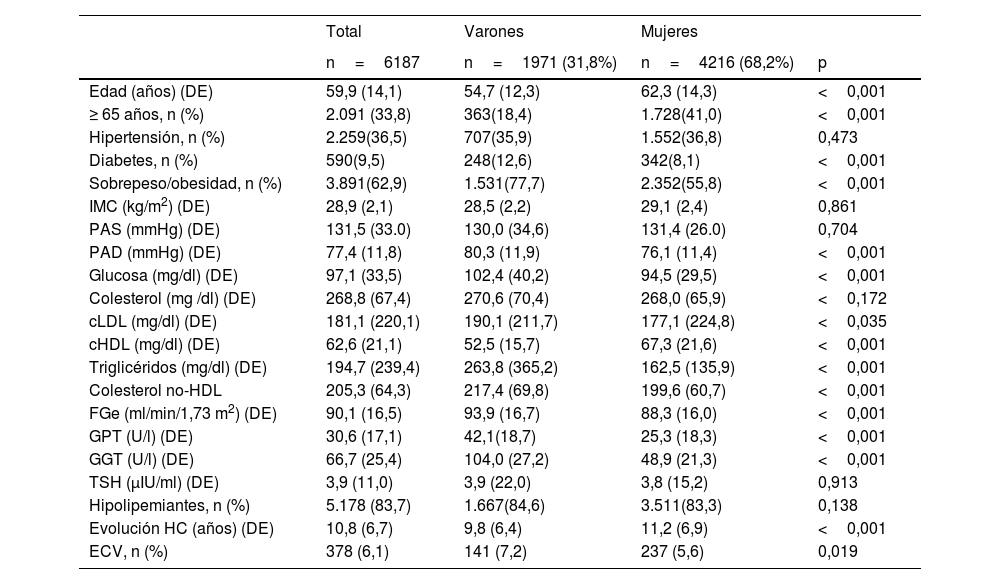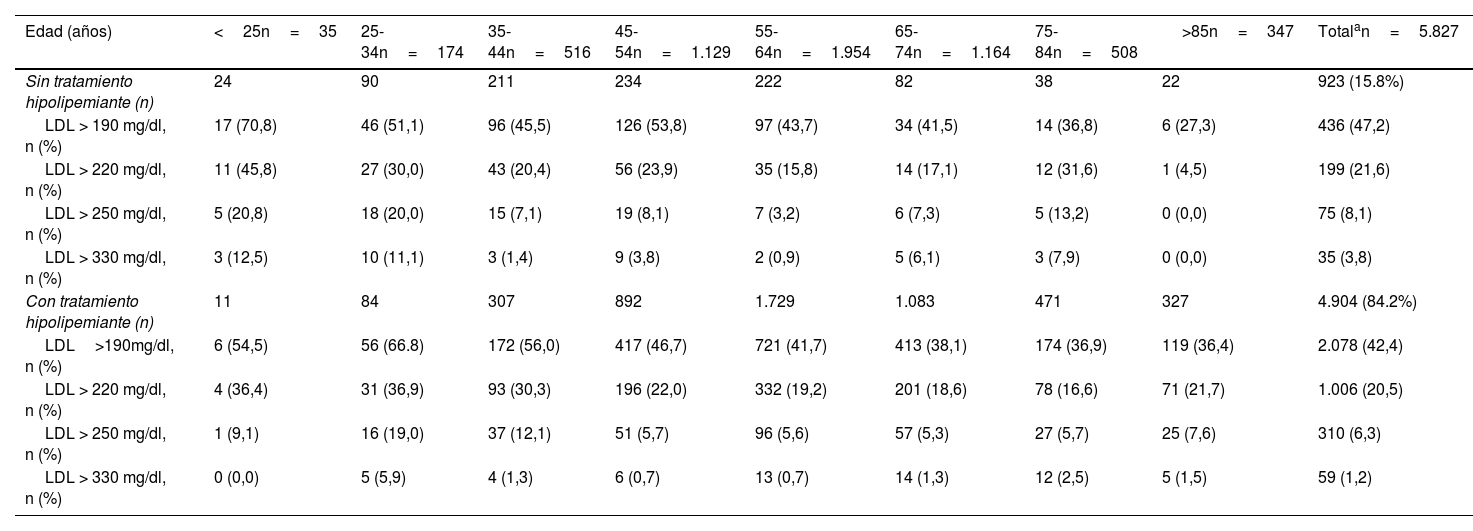Estimar la frecuencia y el perfil clínico de la hipercolesterolemia severa (HS) y del fenotipo de hipercolesterolemia familiar (HF) en el ámbito de atención primaria, en un área sanitaria de la comunidad de Madrid (CAM).
Material y métodosEstudio transversal, multicéntrico de sujetos con tarjeta sanitaria adscritos a 69 centros de salud (área NorOeste/CAM). Se definió HS como colesterol ≥300mg/dl o colesterol-LDL ≥220mg/dl en alguna analítica realizada (1-1-2018 a 30-12-2021), y fenotipo de HF como cLDL ≥240mg/dl (≥160mg/dl si tratamiento hipolipemiante), con triglicéridos <200mg/dl y TSH <5μIU/ml.
ResultadosSe analizaron 156.082 adultos ≥18años con perfil lipídico disponible. 6.187 sujetos tenían HS (3,96% de las analíticas estudiadas; IC95%: 3,87-4,06%). El tiempo medio de evolución del diagnóstico de hiperlipemia en la historia clínica informatizada fue 10,8años; el 36,5% tenían hipertensión, el 9,5%, diabetes, y el 62,9%, sobrepeso/obesidad. El 83,7% tomaban hipolipemiantes (65,7% de baja/moderada y 28,6% de alta/muy-alta intensidad). El 6,1% tenían enfermedad cardiovascular (94,2% tratados con hipolipemiantes), con colesterol LDL <55, <70 y <100mg/dl de 1,8%, 5,8% y 20,2%, respectivamente (vs 1%, 2,3% y 11,2% si no había enfermedad cardiovascular). Mil seiscientos sujetos tenían fenotipo de HF (IC95%: 1,03%, 0,98-1,08%).
ConclusionesCuatro de cada 100 pacientes analizados en atención primaria tienen HS. Hay un elevado nivel de tratamiento farmacológico, pero de insuficiente intensidad, y escaso logro de objetivos terapéuticos. Uno de cada 100 tiene fenotipo de HF. La identificación de ambas situaciones por registros informatizados permitiría su detección más precisa y precoz y establecer estrategias preventivas cardiovasculares.
To examine the frequency of severe hypercholesterolemia (HS) and its clinical profile, and the phenotype of familial hypercholesterolemia (FH), in the primary-care setting in a large health area of the Community of Madrid (CAM).
Material and methodsMulticenter study of subjects with a health card assigned to 69 health centers (Northwest/CAM area). HS was defined as cholesterol ≥300mg/dL or LDL-cholesterol ≥220mg/dL in any analysis performed (1-1-2018 to 12-30-2021); and FH phenotype as c-LDL ≥240mg/dL (≥160mg/dL if lipid-lowering treatment) with triglycerides <200mg/dL and TSH <5μIU/mL.
Results156,082 adults ≥18years with an available lipid profile were analyzed. 6187 subjects had HS (3.96% of the laboratory tests studied, 95%CI: 3.87-4.06%). The mean evolution time of the diagnosis of hyperlipidemia in the computerized clinical record was 10.8years, 36.5% had hypertension, 9.5% diabetes and 62.9% overweight/obesity. 83.7% were taking lipid-lowering drugs (65.7% low/moderate and 28.6% high/very high intensity). 6.1% had cardiovascular disease (94.2% treated with lipid-lowering agents), with LDL-cholesterol <55, <70 and <100mg/dL of 1.8%, 5.8% and 20.2%, respectively (vs. 1%, 2.3% and 11.2% if no cardiovascular disease). 1600 subjects had FH phenotype (95%CI: 1.03%, 0.98-1.08%).
ConclusionsFour out of 100 patients analyzed in primary care have HS, with high treatment level, but insufficient intensity, and poor achievement of treatment goals. One in 100 have the FH phenotype. The identification of both dyslipidemias by computerized records would allow their more precise and early detection and establish cardiovascular preventive strategies.
Artículo
Comprando el artículo el PDF del mismo podrá ser descargado
Precio 19,34 €
Comprar ahora












